The mattress topper market is projected to expand from USD 1.9 billion in 2025 to USD 3.2 billion in 2035, advancing at a CAGR of 5.4%. The growth contribution index shows consistent value increases, with values moving from 1.9 billion in 2025 to 2.3 billion in 2028 and 2.6 billion by 2030. This gradual upward trend reflects growing consumer demand for comfort, support, and sleep quality improvements.
By 2031, the industry value is expected to reach 2.7 billion, progressing to 3.0 billion in 2033 and 3.2 billion by 2035. The growth contribution index demonstrates that the market is evolving from a niche category into a mainstream product, driven by ongoing investments in marketing and expanded distribution channels. Market observers suggest that as consumers continue to prioritize sleep quality and well-being, mattress toppers will remain a popular choice. The index underscores a steady, long-term opportunity, solidifying mattress toppers as an integral part of the bedding market, with significant room for expansion across various regions and demographics.
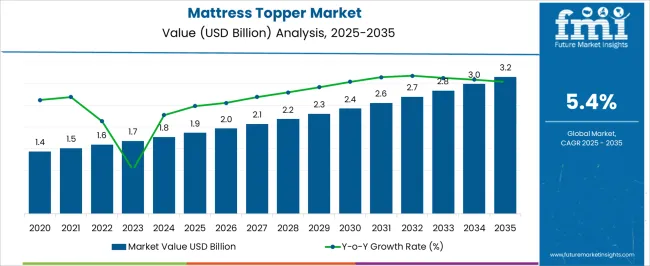
| Metric | Value |
|---|---|
| Mattress Topper Market Estimated Value in (2025 E) | USD 1.9 billion |
| Mattress Topper Market Forecast Value in (2035 F) | USD 3.2 billion |
| Forecast CAGR (2025 to 2035) | 5.4% |
The mattress topper segment is estimated to contribute nearly 18% of the bedding market, about 10% of the home furnishings market, close to 12% of the furniture market, nearly 14% of the sleep products market, and around 8% of the textile home products market. Collectively, this results in an aggregated share of approximately 62% across its parent categories. This proportion highlights the significant role mattress toppers play in enhancing sleep quality and extending the life of mattresses, making them a popular choice in the broader bedding and home furnishings sectors. Their demand has been bolstered by increasing consumer awareness of sleep health, comfort, and the rising desire for affordable ways to improve mattress performance.
The growing trend for customization in bedding solutions, coupled with the demand for specific materials like memory foam, latex, and cooling gels, further strengthens the segment’s prominence. Mattress toppers are recognized for their ability to provide support, relief from pressure points, and temperature regulation, thus enhancing overall sleep experience. This position in parent markets ensures that mattress toppers continue to influence product design, marketing strategies, and purchasing decisions, reinforcing their role as a central category within the broader home furnishings and bedding industries.
Demand is being propelled by rising awareness about the health benefits of proper spinal alignment and pressure relief during sleep. The market is also benefiting from the growing trend of bedroom customization and home improvement, with consumers seeking affordable solutions to enhance the comfort of existing mattresses without full replacements. Technological advancements in material innovation, improved durability, and enhanced breathability are contributing to stronger adoption across diverse demographics.
Rising disposable incomes, coupled with expanding online and offline retail channels, have improved accessibility and product variety. The future outlook remains optimistic as manufacturers continue to innovate in premium materials, sustainable production methods, and temperature-regulating technologies, ensuring the market remains attractive to both value-conscious and premium buyers.
The mattress topper market is segmented by material type, size, end-user, functionality, price, distribution channel, and geographic regions. By material type, mattress topper market is divided into memory foam, gel memory foam, latex, feather and down, wool, polyurethane foam, and fiberfill/polyester. In terms of size, mattress topper market is classified into queen, twin, twin XL, full, king, and other (California king).
Based on end-user, mattress topper market is segmented into Residential and Commercial. By functionality, mattress topper market is segmented into Cooling mattress toppers, Pressure-relief mattress toppers, and Orthopedic mattress toppers. By price, mattress topper market is segmented into Medium, Low, and High. By distribution channel, mattress topper market is segmented into Online and Offline. Regionally, the mattress topper industry is classified into North America, Latin America, Western Europe, Eastern Europe, Balkan & Baltic Countries, Russia & Belarus, Central Asia, East Asia, South Asia & Pacific, and the Middle East & Africa.

The memory foam material type is projected to hold 48.7% of the mattress topper market revenue share in 2025, making it the dominant material segment. This leadership is being attributed to the superior contouring and pressure-relieving properties of memory foam, which have been widely recognized for enhancing sleep quality.
Its adaptability to body shape and weight distribution reduces discomfort and promotes better posture during rest. The segment’s growth has been supported by advancements in foam technology, including gel-infused and open-cell structures, which improve breathability and temperature regulation.
Additionally, memory foam toppers are known for their long lifespan and compatibility with various mattress types, making them a versatile choice for consumers. The continued demand from both residential and hospitality sectors is further reinforcing their market leadership, with manufacturers introducing variations in firmness levels and thickness to cater to a wider range of preferences.

The queen size category is expected to account for 42.9% of the market revenue share in 2025, positioning it as the leading size segment. This dominance is being driven by the widespread use of queen-sized beds in households, offering an optimal balance between sleeping space and room size requirements.
The popularity of this size has been further strengthened by its suitability for both individual sleepers seeking extra space and couples preferring a compact yet comfortable option. The strong presence of queen-sized mattresses in the global market has naturally led to higher topper sales in this category.
Manufacturers have focused on producing a variety of queen-sized toppers in different materials, firmness options, and thicknesses to meet diverse consumer needs. The availability of these products across multiple price points has made them accessible to a broad audience, further supporting the segment’s leadership in the market.
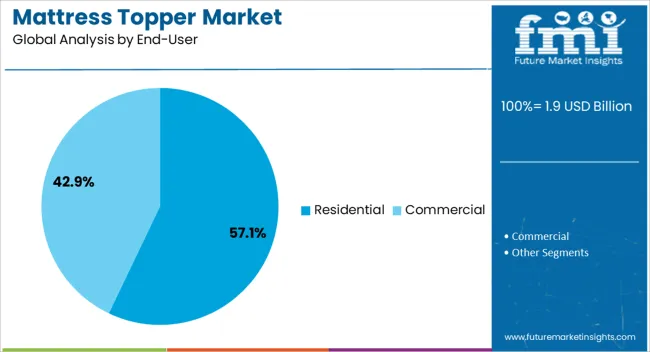
The residential end-user segment is anticipated to capture 57.1% of the market revenue share in 2025, making it the largest consumer category. This dominance is being driven by the increasing focus on enhancing sleep comfort within households, supported by rising disposable incomes and greater awareness of sleep health.
Residential consumers often seek mattress toppers as a cost-effective way to rejuvenate older mattresses or customize the feel of new ones without replacement. The segment’s growth has also been influenced by the growing trend of online shopping, enabling easy comparison and purchase of toppers with diverse specifications.
Seasonal promotions and bundled sales with mattresses have further encouraged adoption in this category. With home improvement and wellness trends continuing to gain momentum, the residential sector is expected to maintain its leadership position, supported by ongoing product innovation and expanded distribution channels.
The mattress topper market is projected to grow steadily, driven by rising consumer demand for improved sleep comfort, pressure relief, and enhanced mattress lifespan. The growing awareness of sleep health and the increasing preference for customizable bedding solutions reinforces demand. Opportunities are unfolding in premium materials, eco-friendly options, and regional product diversification. Trends highlight memory foam, cooling fabrics, and hypoallergenic designs. However, challenges such as pricing pressure, material availability, and competition from other bedding accessories continue to shape the market’s development.
Demand for mattress toppers has been reinforced by the growing emphasis on comfort and sleep quality. Consumers are increasingly seeking mattress toppers to alleviate pressure points, improve sleep posture, and extend mattress life. As awareness of sleep health rises, mattress toppers are being prioritized to enhance overall sleep quality, especially for those with existing mattresses. With a wide variety of options in thickness, material, and firmness, demand is expected to grow in both developed and emerging markets where consumers are willing to invest in comfort-oriented products. As sleep quality is closely tied to well-being, the demand for mattress toppers is projected to remain strong, particularly among middle- to high-income households.
Opportunities in the mattress topper market are expanding through premium materials, eco-friendly alternatives, and region-specific designs. Premium options such as memory foam, latex, and down-alternative fillings are gaining traction as consumers seek better sleep experiences. Eco-conscious buyers are increasingly opting for organic and sustainable toppers made from natural fibers like organic cotton, bamboo, and hemp. As the market becomes more segmented, regional preferences are also creating opportunities for tailored designs, addressing specific climate and cultural preferences. Expansion into emerging markets where disposable incomes are rising is creating further opportunities for premium and eco-friendly mattress topper solutions. These developments indicate that suppliers who focus on offering diverse and eco-conscious products will be well-positioned for long-term success.
Trends in the mattress topper market emphasize the growing popularity of cooling fabrics, hypoallergenic designs, and innovative comfort features. Cooling mattress toppers made from gel-infused memory foam or breathable fabrics are trending as consumers seek relief from overheating during sleep. Hypoallergenic toppers are also gaining attention, particularly among individuals with allergies or sensitive skin. Multifunctional toppers, combining support, temperature regulation, and allergen resistance, are gaining prominence. In addition, the popularity of modular mattress systems, where toppers can be customized based on individual comfort needs, is growing. As consumer preferences evolve toward personalized sleep experiences, these trends highlight the ongoing shift toward versatile, comfort-driven solutions in the mattress topper segment.
Challenges in the mattress topper market arise from pricing pressures, material availability, and intense competition from other bedding accessories. While mattress toppers offer enhanced comfort, their premium pricing can deter cost-sensitive consumers. The market faces significant competition from alternative sleep aids, such as mattress pads and bed toppers made from synthetic materials, which are priced lower. The availability of raw materials such as memory foam and natural fibers may also fluctuate, impacting production timelines and costs. Smaller manufacturers face challenges in competing with larger players who have more established brands and distribution channels. These barriers suggest that, while demand for mattress toppers remains strong, competition and material constraints will continue to impact market dynamics.
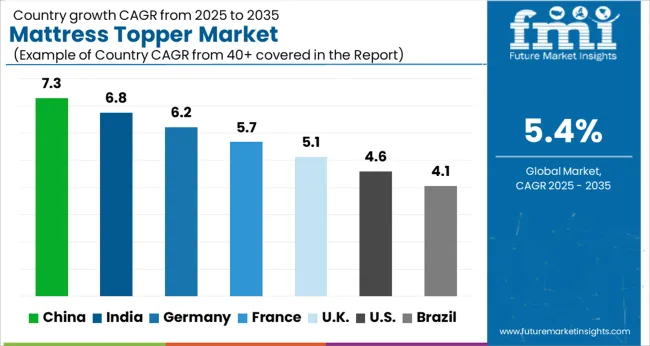
| Country | CAGR |
|---|---|
| China | 7.3% |
| India | 6.8% |
| Germany | 6.2% |
| France | 5.7% |
| UK | 5.1% |
| USA | 4.6% |
| Brazil | 4.1% |
The global mattress topper market is projected to grow at a CAGR of 5.4% from 2025 to 2035. China leads with 7.3%, followed by India at 6.8% and Germany at 6.2%. The United Kingdom is forecast at 5.1%, while the United States records 4.6%. Growth is driven by rising demand for comfort, increased spending on home decor, and growing consumer preference for sleep-related products. Asian markets experience faster growth due to expanding disposable incomes, home ownership, and e-commerce penetration. Europe shows steady growth with increasing interest in premium and eco-friendly mattress toppers. The USA market grows moderately, supported by rising consumer awareness of sleep quality and the growing popularity of adjustable sleep systems. This report includes insights on 40+ countries; the top markets are shown here for reference.
The mattress topper market in China is projected to grow at a CAGR of 7.3%. The expansion is fueled by increasing disposable income, urbanization, and rising consumer focus on comfort and sleep quality. As urban living spaces become smaller, Chinese consumers increasingly prefer affordable solutions to enhance sleep experiences, with mattress toppers becoming a popular choice. E-commerce platforms provide easy access to a wide variety of options, further boosting sales. Domestic manufacturers strengthen their market presence by offering budget-friendly and customizable products tailored to local consumer needs, positioning China as the largest market in Asia for mattress toppers.
The mattress topper market in India is expected to grow at a CAGR of 6.8%. Growth is driven by the increasing popularity of home comfort products, rising consumer awareness about sleep quality, and higher disposable incomes. India’s young and growing middle class, coupled with the growing demand for affordable, high-quality sleep products, reinforces steady market growth. E-commerce platforms play a significant role in driving the sales of mattress toppers, with more consumers choosing online shopping for convenience and product variety. The market is also supported by domestic and international manufacturers offering budget-friendly, durable, and eco-friendly options.
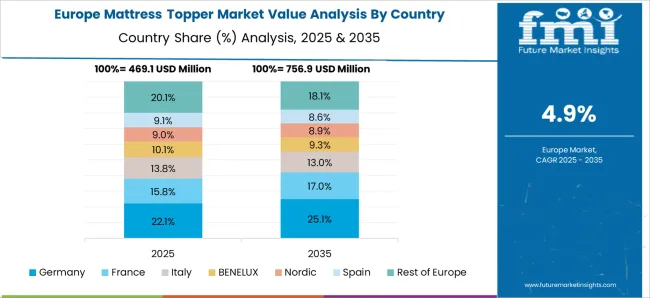
The mattress topper market in Germany is projected to grow at a CAGR of 6.2%. Growth is driven by rising consumer demand for premium and eco-friendly products, as well as an increased focus on sleep quality and comfort. Germans are increasingly opting for high-quality materials, including memory foam, organic cotton, and natural latex. Environmental concerns further drive interest in sustainable and non-toxic sleep solutions. With a focus on durability, quality, and safety, German consumers prioritize premium products, helping to position the country as one of the key European markets for high-end mattress toppers.
The mattress topper market in the UK is forecast to expand at a CAGR of 5.1%. Demand is supported by growing interest in sleep improvement products, particularly among health-conscious consumers seeking better sleep quality. The growing trend for organic and eco-friendly products, combined with rising consumer spending on home comfort items, drives steady growth. The UK market is also supported by a strong retail and online distribution network, which makes mattress toppers more accessible to a wide range of consumers. As the trend toward wellness continues, consumers are increasingly seeking comfort-driven, sustainable products to enhance their sleep environment.
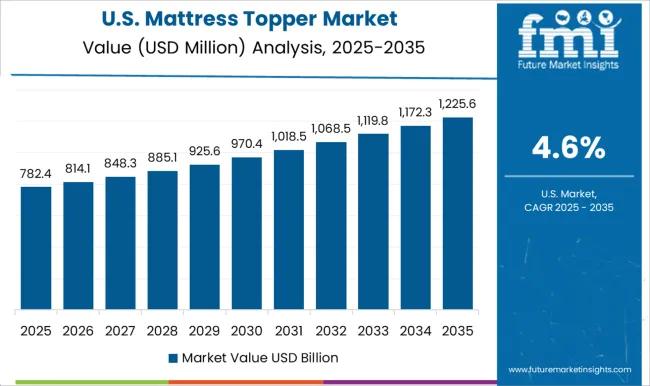
The mattress topper market in the US is projected to expand at a CAGR of 4.6%. Growth is moderate but consistent, supported by the growing awareness of sleep health and comfort. Increasing disposable income and consumer focus on home furnishings drive the demand for high-quality, customizable mattress toppers. Adjustable beds and the rise in sleep technology further fuel the need for products that enhance sleep comfort. While the market growth rate is slower than in Asia, steady consumer demand, particularly in premium and eco-friendly segments, ensures long-term opportunities for growth in the USA
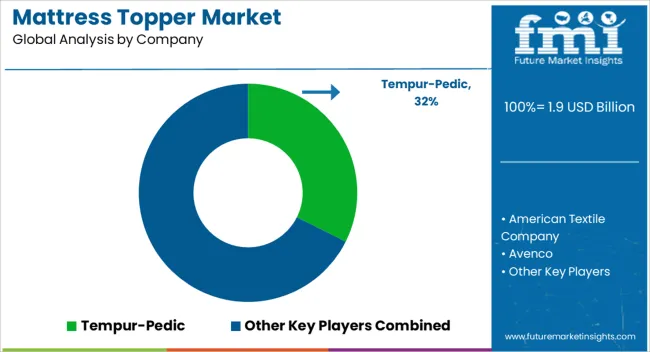
The mattress topper market is highly competitive, driven by growing consumer preference for enhanced sleep comfort, rising awareness of sleep health, and demand for customizable bedding solutions. Competition is influenced by material type (memory foam, latex, feather, wool, or hybrid), thickness, firmness, durability, pricing, and brand reputation. Companies differentiate through innovative materials, cooling technologies, hypoallergenic options, and ergonomic designs that improve sleep quality.
Key players such as Tempur-Pedic, Sleep Innovations, Select Comfort, Malouf, Brooklyn Bedding, ViscoSoft, Lucid, Sleep Number, Saatva, and MyPillow dominate the market, leveraging strong retail presence, e-commerce platforms, and brand loyalty programs. Strategic partnerships with online retailers, direct-to-consumer sales models, and targeted marketing campaigns are commonly employed to expand market reach. Regional and niche manufacturers compete by offering affordable, specialized, or eco-friendly options tailored to local preferences. The market is moderately fragmented, with leading brands emphasizing quality, innovative design, and customer experience to secure long-term loyalty and strengthen their position in a growing market driven by increasing consumer focus on sleep wellness and comfort.
| Item | Value |
|---|---|
| Quantitative Units | USD 1.9 billion |
| Material Type | Memory foam, Gel memory foam, Latex, Feather and down, Wool, Polyurethane foam, and Fiberfill/Polyester |
| Size | Queen, Twin, Twin XL, Full, King, and Other (California king) |
| End-User | Residential and Commercial |
| Functionality | Cooling mattress toppers, Pressure-relief mattress toppers, and Orthopedic mattress toppers |
| Price | Medium, Low, and High |
| Distribution Channel | Online and Offline |
| Regions Covered | North America, Europe, Asia-Pacific, Latin America, Middle East & Africa |
| Country Covered | United States, Canada, Germany, France, United Kingdom, China, Japan, India, Brazil, South Africa |
| Key Companies Profiled | Tempur-Pedic, American Textile Company, Avenco, Bear Mattress, Ikea, Linenspa, Novaform, Restonic Mattress Corporation, Saatva, Sealy Corporation, Serta Simmons Bedding LLC, Silentnight Group, Sleep Innovations, The Purple Mattress, and Zinus |
| Additional Attributes | Dollar sales by material type (memory foam, latex, down alternative, gel), Dollar sales by application (residential, hotel, healthcare), Trends in eco-friendly and cooling technologies, Role in enhancing sleep quality and pressure relief, Growth driven by health-conscious consumers and e-commerce, Regional demand across North America, Europe, Asia Pacific. |
The global mattress topper market is estimated to be valued at USD 1.9 billion in 2025.
The market size for the mattress topper market is projected to reach USD 3.2 billion by 2035.
The mattress topper market is expected to grow at a 5.4% CAGR between 2025 and 2035.
The key product types in mattress topper market are memory foam, gel memory foam, latex, feather and down, wool, polyurethane foam and fiberfill/polyester.
In terms of size, queen segment to command 42.9% share in the mattress topper market in 2025.






Full Research Suite comprises of:
Market outlook & trends analysis
Interviews & case studies
Strategic recommendations
Vendor profiles & capabilities analysis
5-year forecasts
8 regions and 60+ country-level data splits
Market segment data splits
12 months of continuous data updates
DELIVERED AS:
PDF EXCEL ONLINE
Mattress and Mattress Component Market Size and Share Forecast Outlook 2025 to 2035
Mattress And Furniture Bags Market Size and Share Forecast Outlook 2025 to 2035
Mattresses & Accessories Market Analysis - Size, Share, and Forecast Outlook 2025 to 2035
Mattress Pads Market Analysis - Size, Share, and Forecast Outlook 2025 to 2035
Market Share Breakdown of Mattress and Furniture Bags
Air Mattress Market Insights – Growth & Forecast 2019 to 2029
Smart Mattress Market Size and Share Forecast Outlook 2025 to 2035
Latex Mattress Market Growth & Forecast 2025-2035
Queen Mattress Market
Luxury Mattress Market Size and Share Forecast Outlook 2025 to 2035
Heated Mattress Pads Market
Children Mattress Market Product Type, Ingredient Type, Sales Channel, and Region - Trends, Growth & Forecast 2025 to 2035
Hospitality Mattress Market Size and Share Forecast Outlook 2025 to 2035
Innerspring Mattresses Market Analysis - Size, Share, and Forecast Outlook 2025 to 2035
Smart Medical Mattress Market Size and Share Forecast Outlook 2025 to 2035
Down Alternative Mattresses Market Size and Share Forecast Outlook 2025 to 2035
Medical Anti-Decubitus Air Mattress Market Size and Share Forecast Outlook 2025 to 2035
Cat Food Toppers Market Size and Share Forecast Outlook 2025 to 2035
Dog Food Topper Market Analysis - Size, Share, and Forecast 2024 to 2034
Plunger Stopper Market Insights – Trends & Growth Forecast 2024-2034

Thank you!
You will receive an email from our Business Development Manager. Please be sure to check your SPAM/JUNK folder too.
Chat With
MaRIA